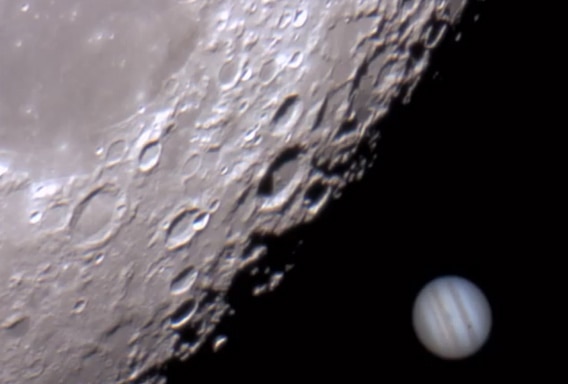Create a free profile to get unlimited access to exclusive videos, sweepstakes, and more!
When the Moon Ate Jupiter

As the Moon orbits the Earth, we see it sliding across the sky, making a complete circle once every month or so. Its motion is slow, almost invisible to the naked eye, though if youâre patient you can see it move very slowly relative to the stars in the sky. Sometimes, it actually passes directly in front of a bright star, an event called an occultation. Less frequently, things line up just so, and it occults something brighter, like a planet.
Last week, from North America, Jupiter and the Moon were very close to together; from my house in Boulder, Colorado they were less than a degree apart (roughly twice the width of the Moon on the sky). But from South America the angle was slightly different, and on Dec. 25, 2012, viewers there saw the Moon directly occult Jupiter.
Via UniverseToday.com I saw this video from astronomer Rafael Defavari, who was able to take video of the event through his Celestron 20 cm. telescope in Brazil!
Thatâs pretty cool. The video is sped up by a factor of five to show the process. At the end he also got a shot of Jupiter reappearing, with its moon
Europa Io popping up just ahead of the planet. You can see the shadow of Europa Io on Jupiterâs cloud tops, too. Bear in mind, the Moon was about 400,000 km (240,000 miles) away at the time, but Jupiter was over 600 million kilometers (360 million miles) farther out! It looks small here, but in reality Jupiter is over 40 times wider than our Moon. [Update: My apologies; I originally misidentified the moon Io as Europa.]Iâve seen a couple of occultations like this in the past. Unfortunately, there wonât be any good ones visible from the United States this coming year, but if you live in South America or Africa youâll get lots of chances: the US Naval Observatory has a list of them coming up. Jupiter and the bright star Spica in Virgo get blocked by the Moon several times over the next few months, and you donât need anything but your eyeballs to see them. If you have a decent-sized telescope, Pluto gets occulted by the Moon a few times as well. Those happen over the Northern Hemisphere, so check the list if you want to try for itâbut youâll need a good âscope and camera to detect faint Pluto, so itâs probably only an event for people who have some experience looking at such things.
You may be wondering why the Moon doesnât block Jupiter (and every other planet) every time it orbits the Earth. Itâs because the Moonâs orbit is tilted with respect to the plane of the solar system. The solar system is flat, so to us the planets appear to move around the Sun in a line on the sky called the ecliptic. But the Moonâs path is tilted, so it can only occult a planet when it crosses the ecliptic and a planet happens to be at that point. Itâs a bit like safely crossing the street; youâre crossing the path that cars travel on, but as long as no cars are actually there when you cross youâre OK.
Most of the time thatâs true for the Moon as well, but sometimes a planet is at that spot, and the Moon glides in front of it, blocking it. Because the Moon is big, and the planets move slowly, in general if you get an occultation one month, you get one or two more over the next couple of months. That's just what we're seeing here.
Unfortunately, from here in the States we donât get to see these Jupiter occulations, but again, if you live south of the Equator, check the USNO site and see if you can watch one!


























